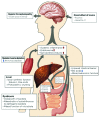The role of microbiota in hepatic encephalopathy
- PMID: 24690956
- PMCID: PMC4153779
- DOI: 10.4161/gmic.28684
The role of microbiota in hepatic encephalopathy
Abstract
Hepatic encephalopathy (HE), which consists of minimal (MHE) and overt (OHE) stages, is a model for impaired gut-liver-brain axis in cirrhosis. Microbiota changes in both stages have been associated with impaired cognition, endotoxemia, and inflammation. There is dysbiosis (reduced autochthonous taxa [Lachnospiraceae, Ruminococcaceae, and Clostridiales XIV] and increased Enterobacteriaceae and Streptococcaceae) with disease progression. In MHE, there is an increased abundance of Streptococcus salivarius linked to cognition and ammonia. In OHE, stool Alcaligenaceae and Porphyromonadaceae are associated with poor cognition. Colonic mucosal microbiome in cirrhosis is significantly different compared with stool and independently related to cognition. HE treatment can affect microbial composition and function; cognitive improvement in MHE after rifaximin, a non-absorbable antibiotic, occurred without significant stool microbiota composition change but improved metabolic linkages. Similarly, there are only modest lactulose and rifaximin-associated changes on microbiota composition in OHE. HE represents an important model to study microbiome-brain interactions.
Keywords: cirrhosis; correlation network; covert hepatic encephalopathy; dysbiosis; endotoxin; lactulose; minimal hepatic encephalopathy; probiotic; rifaximin; systemic inflammation.
Figures

References
Publication types
MeSH terms
Grants and funding
LinkOut - more resources
Full Text Sources
Other Literature Sources
Medical
